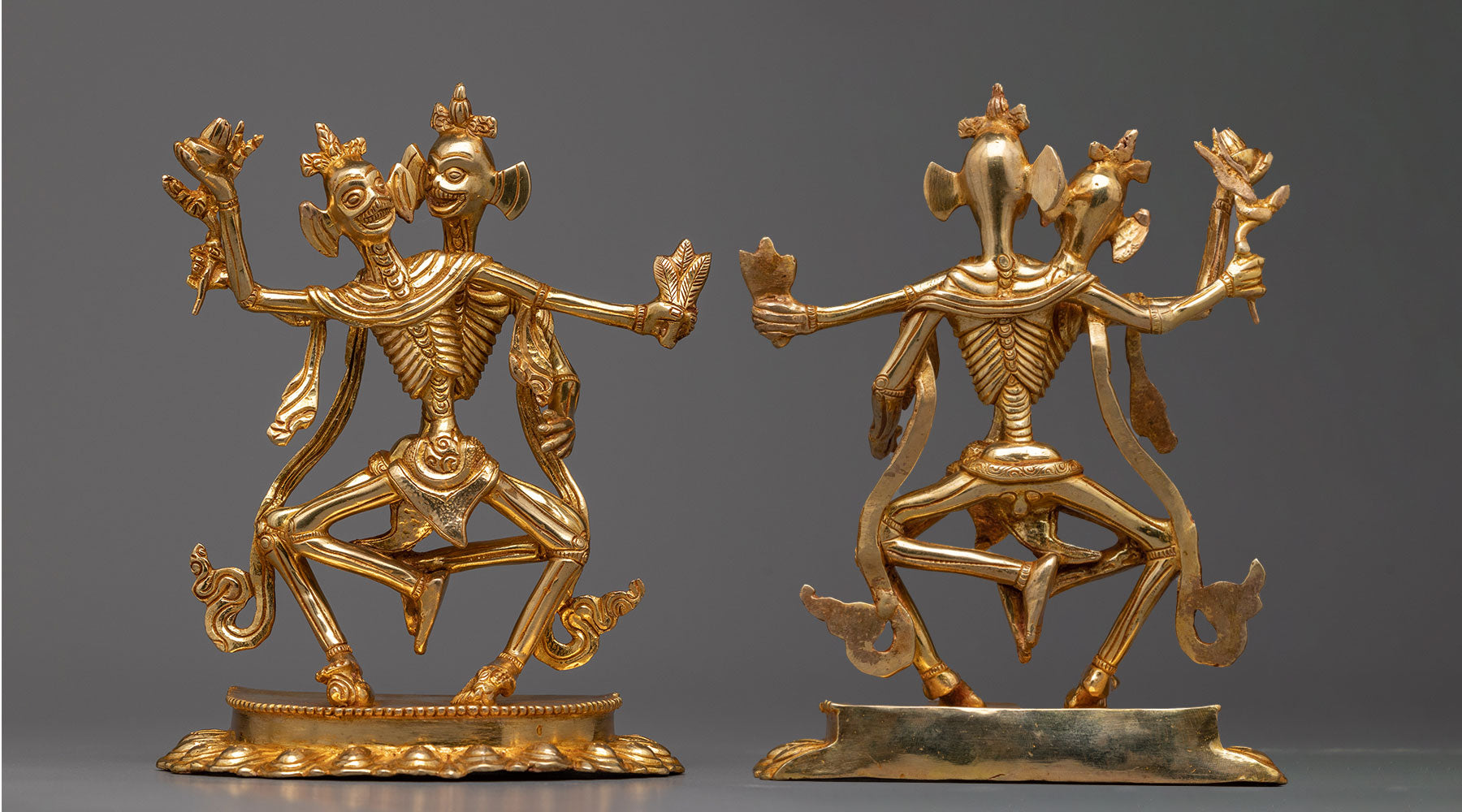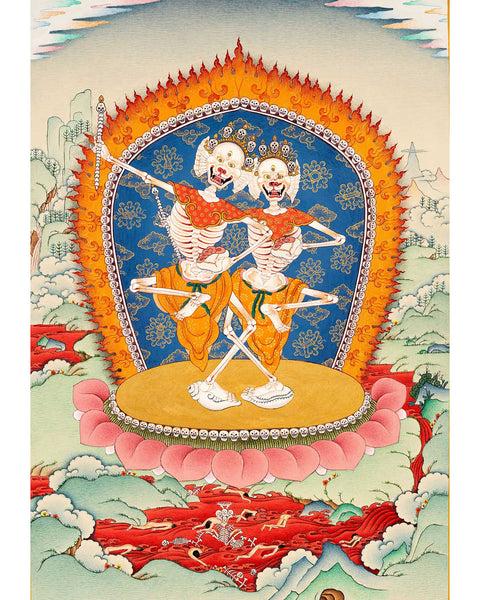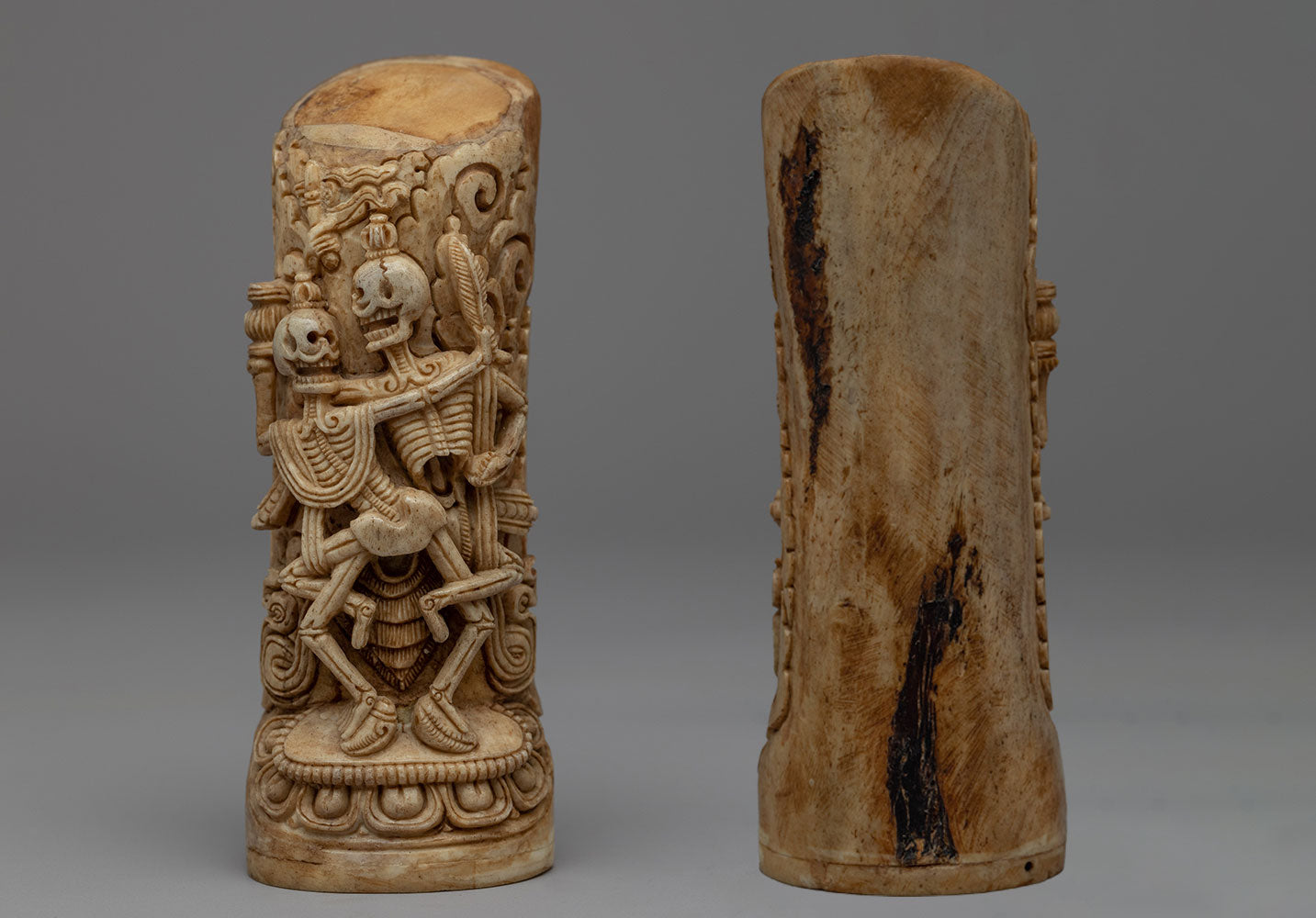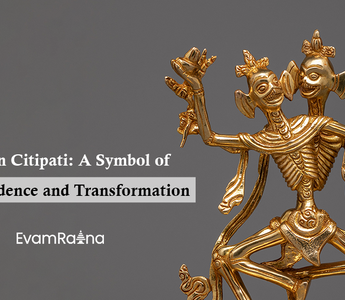Tibetan Citipati: Exploring the Divine Duo of the Charnel Grounds
Citipati, known as the Charnel Ground Deity, is significant in Buddhist and Himalayan traditions. Its mystique has captivated scholars, practitioners, and enthusiasts for centuries.
Often called Shri Shmashana Adhipati or the Lord of the Charnel Ground, Citipati serves as a guardian deity and a potent emblem of metamorphosis.
Key Takeaways:
- Citipati is known as the Charnel Ground Deity.
- This deity has deep roots in Himalayan and Tibetan Buddhism.
- The deity symbolizes the impermanence of life and death.
- Citipati has left its mark on popular culture, particularly in the West.
The Origin of Citipati Tibetan

Click here to view our Gold Gilded Citipati Statue
Citipati finds its origins in Vajrayana Buddhism, particularly within the Tibetan sect. According to a compelling tale, two meditating monks were mistakenly beheaded by a thief who believed them to be lifeless. These monks transformed into the Citipati, assuming the eternal role of guarding charnel grounds.
Although its roots are traced back to India, Citipati gained prominence in Tibetan Buddhism, where it was incorporated into the pantheon of protective deities and revered as Shri Shmashana Adhipati, the Lord of the Charnel Ground.
The term "Citipati" itself finds its roots in the Tibetan language, where "ci" signifies 'fierce' or 'powerful,' and "pati" denotes 'lord' or 'master.' Citipati is often called the "Lords of the Cemetery" or the "Lords of the Charnel Ground."
The origins of this deity are veiled in myth and legend. Some accounts propose its connection to pre-Buddhist Bon practices in the Himalayan region, while others perceive it as a manifestation of wrathful Buddhist deities. Regardless of its precise inception, Chitipati has grown to become an integral facet of Himalayan and Tibetan Buddhist traditions.
Charnel Grounds in Himalayan Culture
Within Himalayan cultures, charnel grounds occupy a distinct role in religious customs. They are designated sites where bodies are left to decompose naturally, embodying a tradition that acknowledges the impermanence of life.
These grounds are believed to be inhabited by spirits and deities, among them Citipati, who holds a significant role in the rituals and meditations conducted in these sacred spaces.
Iconography of Citipati

Click here to view our Citipati Thangka Art
The imagery of Citipati is captivating and haunting, making it instantly recognizable to those familiar with Tibetan Buddhism. This section delves into the striking iconography of this deity.
-
The Dance of the Skeletons
Citipati is most frequently depicted as a pair of dancing skeletons, their movements exuberant. One leg is raised high, while the other touches the ground, their bony arms intertwined as they hold a skull cup brimming with offerings.
-
Crowns of Wisdom Flames
An unmistakable aspect of Citipati's iconography is the presence of wisdom flames atop their skulls. These flames symbolize the transformation of wisdom and the enlightenment of the mind achieved through the realization of impermanence.
-
Necklaces of Human Heads
Another striking feature of the deity is the necklaces crafted from human heads, representing the ego and the attachment to the physical body. This underscores the impermanence of life and the imperative to transcend the material world.
Symbolism in Dance
The dance of Citipati holds profound symbolism, signifying the eternal cycle of life, death, and rebirth that encompasses all living beings. In this intricate representation, the raised leg represents transcendence from the mundane, while the grounded leg symbolizes the connection to the earthly realm.
The Significance of Citipati
Citipati's significance reaches deep into the heart of Buddhist philosophy and practice, particularly in Tibetan Buddhism. Let's delve into how this deity fits into the broader Buddhist context.

The presence of Citipati in Buddhist traditions holds profound importance. This section explores the deeper meanings and implications of this deity's role.
-
Embracing Impermanence
Arguably, the most significant role of Citipati is aiding individuals in accepting impermanence. In a world where attachment to material possessions and fear of death often dominate, Citipati's magery stands as a stark reminder that all things are fleeting. -
Overcoming Fear
Citipati's iconography, featuring death and decay, may evoke discomfort, yet it presents an opportunity for spiritual growth. By confronting the fear associated with death, practitioners can learn to release attachments and ego-driven desires. -
The Dance of Life
Citipati's dance conveys the perpetual cycle of life, death, and rebirth, emphasizing their interconnectedness and the potential for a deeper understanding of existence. -
Compassion and Liberation
Within Buddhist philosophy, comprehending impermanence and the nature of suffering is a pivotal step towards liberation from the cycle of samsara (birth, death, and rebirth).
Citipati's presence in Buddhist practice serves as a reminder that compassion, wisdom, and the courage to confront one's fears are essential on the path to enlightenment.
-
Symbol of Impermanence
At the core of Buddhist teachings lies the principle of impermanence. Citipati's imagery serves as a potent reminder of this fundamental Buddhist concept.
The dance of the skeletons, along with the presence of skulls and severed heads, underscores the transient nature of life and the inescapable reality of death.
-
Protective Deities
Citipati is frequently invoked as a protective deity within Tibetan Buddhism. Practitioners seek the blessings and guidance of Citipati, particularly in matters related to death and the afterlife.
The deity is believed to assist souls in navigating the intermediate state (bardo) and transitioning to their next rebirth.
-
Tantric Practices
In certain Tibetan tantric practices, Citipati is called upon for its fierce and wrathful attributes. These practices aim to harness the deity's energy to surmount obstacles on the spiritual journey. Citipati's dance symbolizes the fierce determination to confront and transcend the ego.
Citipati Mantra Practice
Devotees often incorporate the Citipati mantra into their meditation and rituals, believing it invokes the protective and transformative aspects of Citipati.
Citipati in Popular Culture
The imagery and symbolism of Citipati have transcended the boundaries of Buddhism and impacted popular culture.
-
Art and Tattoos
Citipati's compelling imagery, featuring dancing skeletons, wisdom flames, and human head necklaces, has captivated artists and tattoo enthusiasts worldwide. It has become a popular choice for body art, reflecting themes of impermanence and transformation.
-
Music and Film
In the realms of music and film, Citipati has occasionally made appearances. Its iconography has been integrated into album artwork and music videos and is a thematic element in some movies. Its eerie yet captivating presence adds a unique layer of symbolism to these creative works.
-
Fashion and Merchandise
Fashion designers and brands have embraced Citipati's imagery, incorporating it into clothing and merchandise lines. The stark and thought-provoking visuals appeal to those who appreciate the fusion of spirituality and aesthetics.
-
New Age and Spiritual Practices
Citipati's symbolism resonates with individuals engaged in New Age and spiritual practices. It is often regarded as a symbol of transformation, inner awakening, and the journey towards self-realization.
Lessons from Citipati
The reverence for Citipati extends beyond mere deity worship, encompassing valuable life lessons. The critical teachings from this enigmatic figure can be distilled as follows:
- Impermanence of Life: Embrace the reality that everything in life is transient rather than fearing it.
- Cycle of Life and Rebirth: Understand that death is a transformation, not an endpoint.
- Respect for the Dead: Learn from Citipati's role in guarding charnel grounds to respect the departed and appreciate the sanctity of death.
Citipati, the Charnel Ground Deity, transcends religious and cultural boundaries with its multifaceted symbolism of impermanence, the dance of life, and the courage to face fear. These teachings have profound implications for Buddhist practice and the broader human experience.
Furthermore, its enduring presence in popular culture underscores the ongoing fascination with life's mysteries and the enduring impact of symbolism. Whether encountered in a Tibetan monastery, a tattoo parlor, or a music video, Citipati's image inspires contemplation and curiosity, reminding us of the ceaseless wheel of existence and the enduring power of symbolism to transcend time and place.














